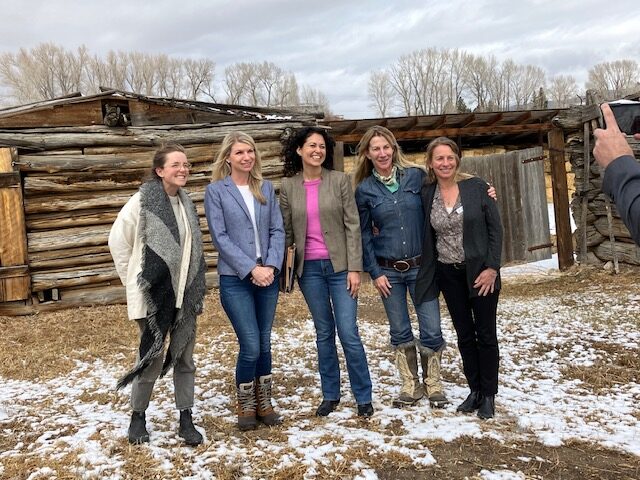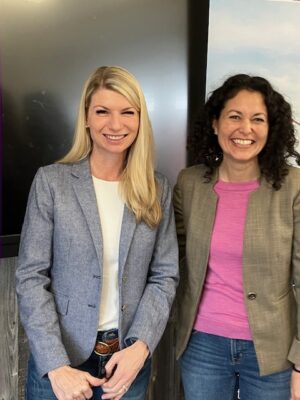
The rural development meeting at the Guidestone education center at Hutchinson Ranch included second from left Representative Brittany Pettersen and USDA Under Secretary for Rural Development Xochitl Torres Small and their staffs. Not pictured, Colorado Rural Development Director Armando Valdez. Photo by Jan Wondra.
U.S. Representative Brittany Pettersen (CO-07) recently joined U.S. Department of Agriculture (USDA) Rural Development Under Secretary Xochitl Torres Small and USDA State Director Armando Valdez for a roundtable discussion with community leaders and local officials at the Guidestone Education Center located at the Hutchinson Ranch in Salida, Colorado.
The March 16 morning session centered around federal efforts to support and further develop rural communities, specifically by tackling workforce development, housing, utilities, and broadband challenges. The stated purpose of the USDA Rural Development (RD) program is to act as a catalyst for rural prosperity, through loans, grants, and partnerships across more than 40 different programs.
Valdez admitted that it can be hard to access the federal programs to move rural projects ahead and that one of the major challenges has been simply to let those who might benefit know about them.
Not only does the plethora of programs and services make it hard for rural communities to navigate, but people may think they need to have a recommended solution to walk in the door. But Valdez encouraged the group saying, “You don’t have to walk in and say this is our plan. Even if you walk in and say ‘This is our challenge’, even if you don’t yet have a plan … we can ideate with you to help determine which program and what steps might help you achieve a solution.”

Rep. Brittany Pettersen and USDA Under Secretary for Rural Development Xochitl Torres Small at the rural development meeting at Guidestone on March 16, 2023. Photo by Jan Wondra
The programs are numerous, including partnerships and funding for:
- Rural utility services — broadband, telecommunications, water, and electric
- Rural business-cooperative services — which include business, energy, cooperatives, and community economic development
- Rural housing services — single-family housing, multi-family housing, and community facilities.
It was no surprise that among the many topics raised by county attendees, they wanted to know what federal programs are available to address one of the highest priorities of the county; the great need for all kinds of housing, both workforce and senior housing.
“We fund the building of apartment facilities and providing rental facilities, but we don’t construct many of them anymore or fund money for new facilities,” said Torres Small. “It’s a recurring request from the President; can we fund more of them? … we are being asked and this isn’t funded. The [federally-funded] housing stock is 30-35 years old and we need to start investing in new buildings as well.”
She added that her RD team “is regularly asked about workforce housing. For our single-family housing, it’s usually single parents. Our requests for multi-family housing are usually for senior citizens, who maybe are just living on Social security. That’s one part of the population for rural places, but then there is the workforce.”
“We need the middle part too — the workforce housing,” interjected Buena Vista Mayor Libby Fay.
“Yes, what we’ve seen is community facilities where a nonprofit or business and industry guaranteed loans,” said Torres Small. “Right now we can only spend a certain portion of funding [of a project] on housing. But we have seen where they are building a clinic and they add a couple of workforce housing units for the nurses. Or, for business, you can construct a hotel, but the rules say you can’t just construct permanent housing. For instance a light industrial site with a café, you can also set up a tiny amount of housing on those sites, but not a lot.”
“We can build individually-owned townhomes that qualify as single-family homes, but not as multi-owned units,” said Valdez. “The applicants are often nonprofits, towns, local small districts, and counties.”
Torres Small pointed out the importance of local governments conducting housing audits, noting that the RD team can help get funding to conduct them so that there is data to support loan or grant requests.
“It’s undersubscribed in our state,” added Valdez. “It’s one of our technical assistant grants that are out there and falls within our community programs area — it’s 25 percent or less that can be focused on housing. Frankly, on our side, we need to promote it more. We’re asking ourselves, how do you change this to let people know which programs are out there that give you access to strengthening, planning, and technical assistance?” he added thoughtfully.
“No one really owns this issue,” said Pettersen about the awareness problem.
The crisis topic of early childhood care was raised by Buena Vista Trustee Gina Lucrezi. “We have a childcare crisis here. One of the projects we’re doing with Fading West is to facilitate a childhood development center. We don’t have a lot of that in the valley, I can only speak to BV — but we need help funding it.
“We have experienced the challenge,” said Torres Small. “If you’re looking for funding nonprofits the facilities loan grant fits that… We’ve seen childcare cooperatives get funding.”
Pettersen, who is a young mother herself said while in the Colorado State Legislature, she worked on childcare funding resources.
As usual, the urgent need for better broadband connectivity in the region and in local gap areas was raised.
Valdez told the group that the USDA RD has two programs: Community Connect to cover smaller defined community areas, and Reconnect, which can cover larger geographic areas Community Connect is an $80 million project across the country that is now ready for rollout — it can help pay for the middle line connection.
Pettersen reminded the group that “We’re not always going to have the Undersecretary with us to identify the opportunities for funding. One of the things that I did at the state level, on which we need help is addressing the lack of support in rural areas for even hearing about the [federal] grants and the need for help apply for grants in small communities. Are there opportunities for federal help for this?”
Torres Small said there are a few federal grants to help, but admitted that “it is really hard to apply — it puts rural communities at a big disadvantage when they are up against larger areas that have entire departments that write grants.” She added that the USDA RD has just started a Navigator program and now has 16 Navigators in Colorado to help rural areas.
The closest USDA offices to Chaffee County are Alamosa and Lakewood. But the USDA RD team said that the location doesn’t matter, “Whichever person or office you talk with, you can even walk into the Craig office, we’re a team here to help you,” said Valdez.
Asked by Ark Valley Voice what was the most surprising thing she had heard during her time in Chaffee County, Torres Small said, “Well, this wasn’t a question, but I noted it as surprising. There is so much that the communities are trying to do together. Dedicating the percentage of your lodging tax for one thing. I’m also interested in how the nonprofits are participating in this — going back to tech assistance, I’m intrigued about how nonprofits might be part of this mix.”







Recent Comments